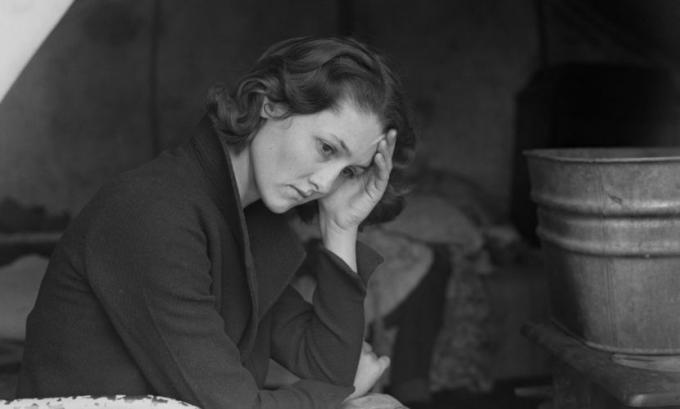THE 1929 crisis It was the biggest economic crisis in the history of the United States and the capitalism, caused by the overproduction of the North American industry, lack of regulation of the economy, excess of credit and speculation in the Stock Exchange. This crisis caused thousands of companies to fail and millions of workers to lose their jobs.
accessalso: Encilhamento — the economic policy that generated a serious crisis in the early years of the Republic of Brazil
Summary on the 1929 Crisis
The Crisis of 1029 was the biggest economic crisis in the history of capitalism.
It was caused by overproduction, lack of regulation of the economy, excess credit and the speculation bubble.
It began with the crash of the New York Stock Exchange in October 1929.
It caused thousands of companies to fail and millions of workers to be unemployed.
The main product from Brazil to be affected was coffee, produced mainly for export.
Video lesson on the 1929 Crisis
Historical context of the 1929 Crisis
The 1920s were marked as the beginning of the greatest economic crisis in the history of the United States and capitalism. However, before this major crisis, this decade had stood out as a
period of euphoria and boundless prosperity in American memory.In the United States, the 1920s became known as the roaring twenties, a term that was translated into Portuguese as “crazy years twenties”. This expression was used to define the climate of American society in the 1920s. This is because the United States was experiencing a cycle of prosperity never seen in the country's history.
THE US economy was booming since before First World War, but with the end of the conflict, the United States undoubtedly assumed the position of the greatest economic power on the planet. This is because the country prospered greatly from the war, not having been hit by combat.
Thus, the North American industry became responsible for the production of a large part of the goods that were consumed on the planet. In addition, the country became creditor of European nations recovering from war. This means that the United States started importing goods and lending money in large volumes to Europe, mainly.
The advance of the American economy and industry established what became known as American way of life, the “American way of life”. This way of life was based on a high consumption of goods, many of them unnecessary. Among the main goods consumed at the time were home appliances.
This euphoria caused the North American industry to start producing goods unbridled, without caring if the market would be able to absorb them. In addition, the climate of economic enthusiasm also made the banks start to carry out a large amount of loans, without paying attention to whether there would be a return and also without regulation on these.
Finally, the economic excitement encouraged thousands of people to invest their capital in stocks on the Stock Exchange. THE large number of people investing in stocks made their value soar, reinforcing the feeling of prosperity.
accessalso: Treaty of Versailles — the treaty that ended World War I
Causes of the 1929 Crisis
Taking this context into account, some points can be highlighted in relation to the facts that motivated the 1929 Crisis:
increase in production without the market being able to absorb the goods produced;
carrying out a large number of loans;
lack of regulation on transactions;
recovery of the European economy;
currency speculation.
Let's understand this scenario. First, the increase in US production was not accompanied by measures that would allow for the absorption of these goods. In the post-war period, most of them were consumed by the European market, but the economic recovery in Europe caused the demand for North American products to decrease.
Furthermore, there was an important fact in the North American territory itself. The country's workers, that is, potential consumers, did not obtain salary gains. So, the purchasing power of workers continued the same and, naturally, they were not in a position to consume all that was produced.
In addition, the amount of credit that was being made available collided with a factor: many did not pay the loans they had requested. The packed goods and the default in the banks affected the euphoria of the market and its consequences reached the New York Stock Exchange.
On October 24, 1929, the climateindistrustcaused 12 million shares to be put up for sale. This put the market in a panic, and the picture remained on the 28th, when 33 million shares were put up for sale. The next day, October 29, 1929, the stock market crashed and the stock price plummeted..
Immediately, stocks that were worth thousands of dollars were worth absolutely nothing, and several American companies that had their capital invested in the Stock Exchange went bankrupt. Many of the companies that did not go bankrupt lost part of their assets and had to lay off employees.
Layoffs increased as companies went bankrupt. All this meant that bank loans were not repaid. In addition, the panic created by this situation caused thousands of people to go to banks to withdraw their money to protect themselves. This drove hundreds of banks into bankruptcy as all funds were withdrawn by customers.
Consequences of the 1929 Crisis

The crash of the New York Stock Exchange ushered in the period of the Great Depression. From 1929 to 1933, the United States experienced the worst moment of the economic crisis. However, from 1933 onwards, a gradual recovery began to take place in the country. In general, the effects of the 1929 Crisis were felt until the middle of the Second World War.
Among the consequences of the 1929 Crisis, the huge number of bankruptcies that occurred in the United States, in addition to the exponential increase in the unemployment rate in the country, stand out. THE US unemployment jumped from 4% before the crisis to 27% population after the stock market crash.
THE GDP of the country has decreased, the amount of imports and exports has decreased, industrial production has been reduced and workers' wages have fallen. Furthermore, the effects of the 1929 Crisis were not restricted to the United States and spread to different countries, especially European ones.
There in Europe, the number of unemployed has increased considerably, and the consequences of the economic crisis have served as impetus for the growth of totalitarian movements, like the Nazism, in Germany, the fascism, in Italy.
The effects of the Great Depression only began to be overcome in 1933, when the US government implemented the newdeal (New Agreement), a program of state intervention in the economy. The purpose of this program was to revive the US economy. Among the actions carried out, for example, the creation of public works to guarantee employment for US citizens stands out.
accessalso: What were the causes of World War II?
Crisis of 1929 in Brazil
Here in Brazil, the The greatest impact of the 1929 Crisis was on the exports that the country did. Brazil was the major international coffee producer and the United States was the biggest consumer of this Brazilian product. With the crisis, the movement of Brazilian coffee stalled, as the volume of North American imports was drastically reduced.
So, the coffee price plummetsor in the international market. The coffee growers pressured the Brazilian government to take action in relation to this situation. In 1930, Getúlio Vargas assumed the presidency and decided that the government would buy the coffee sacks from the coffee growers and burn them.
Thus, Brazil would assume the loss of coffee growers and would still destroy the coffee to guarantee the price of the commodity on the international market. In addition, a body responsible for taking care of the coffee business in Brazil was created. This body became known as the National Coffee Council.

